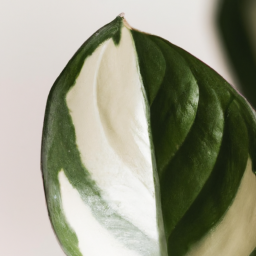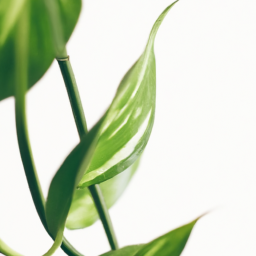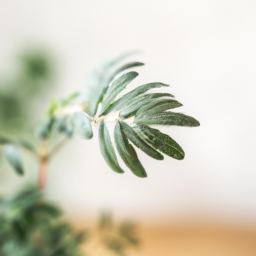
Have you ever wanted to bring some greenery into your home but struggled to find a spot with enough natural light? Well, you’re in luck because today we’re going to talk about plants that need no light! Yes, you read that right – there are actually plants out there that can thrive in low-light conditions. Whether you’re a busy urban dweller with limited windows or just looking to add some green to a dark corner of your home, these plants are perfect for you. So sit back, relax, and let’s explore the wonderful world of plants that need no light.
Benefits of Low-Light Plants in Indoor Spaces
Introduction
When it comes to adding greenery to your indoor spaces, low-light plants are a great option. These plants are perfect for areas that don’t receive much natural light, such as bathrooms or offices with small windows. Not only do low-light plants add a touch of nature to your home or workspace, but they also offer a range of benefits for both your physical and mental well-being.
Improving Air Quality
One of the key benefits of having low-light plants in indoor spaces is their ability to improve air quality. Plants are natural air purifiers, absorbing carbon dioxide and releasing oxygen through the process of photosynthesis. Low-light plants like snake plants, pothos, and peace lilies are particularly effective at filtering out toxins such as formaldehyde and benzene from the air, helping to create a healthier indoor environment.
In addition to removing harmful pollutants, low-light plants also help to increase humidity levels in indoor spaces. This can be especially beneficial during the winter months when the air tends to be drier due to heating systems. By releasing moisture into the air through a process known as transpiration, plants can help to alleviate symptoms of dry skin, sore throats, and respiratory issues.
Furthermore, having plants in your indoor spaces can help to reduce the levels of dust and allergens in the air. The leaves of plants act as natural filters, trapping particles and improving overall air quality. This can be particularly beneficial for individuals who suffer from allergies or asthma, as cleaner air can help to alleviate symptoms and improve respiratory health.
Boosting Mental Well-Being
In addition to the physical benefits of having low-light plants in indoor spaces, these green companions can also have a positive impact on your mental well-being. Studies have shown that being around plants can help to reduce stress, anxiety, and depression. The presence of greenery indoors has a calming effect, promoting relaxation and a sense of tranquility.
Taking care of plants can also be a therapeutic activity, providing a sense of purpose and accomplishment. Watering, pruning, and tending to your plants can help to create a daily routine and foster a sense of mindfulness. Watching your plants grow and thrive can be incredibly rewarding, boosting your mood and overall sense of well-being.
Furthermore, having plants in your indoor spaces can help to increase productivity and creativity. Research has shown that being in the presence of plants can improve concentration, memory, and cognitive function. This can be particularly beneficial for individuals who work from home or spend long hours indoors, as plants can help to create a more stimulating and inspiring environment.
In conclusion, low-light plants offer a range of benefits for indoor spaces, from improving air quality to boosting mental well-being. By incorporating these green companions into your home or workspace, you can create a healthier, happier, and more productive environment for yourself and those around you. So go ahead and bring some greenery into your indoor spaces – your mind and body will thank you!

Top 5 Plants That Thrive in Low-Light Environments
Introduction
When it comes to indoor plants, finding the right ones for low-light environments can be a challenge. However, there are several plants that can thrive in low-light conditions, making them perfect for offices, bathrooms, or any room with minimal sunlight. In this article, we will explore the top 5 plants that need no light and how to care for them.
Peace Lily
Peace lilies are one of the most popular indoor plants for low-light environments. These plants have dark green leaves and beautiful white flowers that can brighten up any room. Peace lilies are known for their air-purifying properties, making them a great choice for offices or bedrooms.
To care for a peace lily, place it in a spot with indirect sunlight and water it regularly. Keep the soil moist but not waterlogged, and mist the leaves occasionally to increase humidity. Peace lilies are sensitive to chemicals in tap water, so it’s best to use distilled or filtered water when watering them.
If your peace lily starts to droop, it may be a sign that it needs more water. Simply give it a good drink and it should perk up within a few hours. With proper care, peace lilies can thrive in low-light environments and add beauty to your space.
Snake Plant
Snake plants, also known as mother-in-law’s tongue, are another great option for low-light environments. These plants have tall, upright leaves that come in a variety of colors and patterns. Snake plants are incredibly easy to care for and can survive in almost any lighting conditions.
To care for a snake plant, place it in a spot with indirect sunlight and water it sparingly. Snake plants are drought-tolerant and prefer to dry out between waterings. Overwatering can cause root rot, so it’s best to err on the side of underwatering when caring for a snake plant.
Snake plants are also known for their air-purifying properties, making them a great choice for bedrooms or living rooms. With their unique appearance and low-maintenance care requirements, snake plants are a must-have for any low-light space.
Cast Iron Plant
Cast iron plants are aptly named for their durability and ability to thrive in low-light environments. These plants have dark green, leathery leaves that can withstand neglect and low humidity. Cast iron plants are perfect for beginners or anyone looking for a low-maintenance plant.
To care for a cast iron plant, place it in a spot with indirect sunlight and water it sparingly. These plants are drought-tolerant and prefer to dry out between waterings. Cast iron plants can also tolerate a wide range of temperatures, making them ideal for offices or bathrooms.
With their tough foliage and ability to thrive in low-light conditions, cast iron plants are a great choice for anyone looking to add greenery to their space without a lot of fuss. Simply water them occasionally and watch them thrive in even the darkest corners of your home.
ZZ Plant
ZZ plants, also known as Zamioculcas zamiifolia, are another great option for low-light environments. These plants have glossy, dark green leaves that can brighten up any room. ZZ plants are incredibly easy to care for and can survive in almost any lighting conditions.
To care for a ZZ plant, place it in a spot with indirect sunlight and water it sparingly. These plants are drought-tolerant and prefer to dry out between waterings. ZZ plants are also known for their air-purifying properties, making them a great choice for offices or bedrooms.
With their unique appearance and low-maintenance care requirements, ZZ plants are a great choice for anyone looking to add greenery to their space without a lot of fuss. Simply water them occasionally and watch them thrive in low-light environments.
Spider Plant
Spider plants are another popular choice for low-light environments. These plants have long, arching leaves with white stripes that can add a touch of elegance to any room. Spider plants are known for their air-purifying properties and ability to thrive in low-light conditions.
To care for a spider plant, place it in a spot with indirect sunlight and water it regularly. Spider plants prefer to dry out between waterings, so be sure not to overwater them. These plants also benefit from occasional misting to increase humidity and prevent brown tips on the leaves.
If your spider plant starts to produce baby spider plants, simply cut them off and plant them in their own pot to propagate new plants. With their graceful foliage and easy care requirements, spider plants are a great choice for anyone looking to add greenery to their space.
In conclusion, there are several plants that can thrive in low-light environments, making them perfect for offices, bathrooms, or any room with minimal sunlight. Peace lilies, snake plants, cast iron plants, ZZ plants, and spider plants are all great options for low-light spaces. By following the care tips outlined in this article, you can enjoy beautiful, healthy plants in even the darkest corners of your home.

Tips for Caring for Plants That Require Minimal Light
Are you looking to add some greenery to your space but don’t have much natural light? No worries! There are plenty of plants that can thrive in low-light conditions. In this guide, we’ll explore some tips for caring for plants that require minimal light so you can create a lush indoor oasis without the need for direct sunlight.
Choose the Right Plants
When selecting plants that require minimal light, it’s important to choose species that are well-suited for low-light conditions. Some popular options include pothos, snake plants, and peace lilies. These plants are known for their ability to thrive in indirect sunlight, making them perfect for homes or offices with limited natural light.
In addition to selecting the right species, it’s also important to consider the specific needs of each plant. Some plants may require more water or humidity than others, so be sure to research the care requirements for each plant you choose.
When caring for plants that require minimal light, it’s important to provide them with the right environment to thrive. This includes ensuring they have access to indirect sunlight, proper watering, and a suitable temperature and humidity level. By choosing the right plants and providing them with the care they need, you can create a beautiful indoor garden that will thrive in low-light conditions.
Provide Adequate Watering
One of the most important factors in caring for plants that require minimal light is providing them with adequate watering. While these plants may not need as much sunlight as other species, they still require regular watering to thrive. Be sure to check the soil moisture levels regularly and water your plants when the top inch of soil is dry.
When watering plants that require minimal light, it’s important to use room temperature water and avoid overwatering. Overwatering can lead to root rot and other issues, so be sure to allow the soil to dry out between waterings. Additionally, be mindful of the specific watering needs of each plant species, as some may require more water than others.
By providing your plants with the right amount of water, you can help them thrive in low-light conditions and create a healthy indoor environment. Remember to monitor the soil moisture levels regularly and adjust your watering routine as needed to ensure your plants stay happy and healthy.
Ensure Proper Drainage
In addition to providing your plants with adequate water, it’s also important to ensure they have proper drainage. Plants that require minimal light can be sensitive to overwatering, so it’s essential to use pots with drainage holes to allow excess water to escape. This will help prevent waterlogged soil and root rot, which can be detrimental to your plants’ health.
When selecting pots for your low-light plants, be sure to choose containers with drainage holes in the bottom. This will allow excess water to drain out of the soil, preventing water buildup and promoting healthy root growth. Additionally, be sure to use a well-draining soil mix that will allow water to flow freely through the roots and prevent waterlogged conditions.
By ensuring your plants have proper drainage, you can help them thrive in low-light conditions and prevent issues such as root rot and mold. Be sure to monitor your plants regularly and adjust their care routine as needed to ensure they have the best chance of success in your indoor space.
Essential Points
Are you a plant lover but struggle to keep your indoor plants alive because of poor lighting conditions? Well, fear not! There are actually several plants that thrive in low-light environments and require minimal sunlight to survive. These plants are perfect for brightening up dark corners in your home or office without the need for direct sunlight.
Some popular low-light plants include the snake plant, pothos, and peace lily. These plants are not only easy to care for but also have air-purifying properties, making them a great addition to any indoor space. So, if you’re looking to add some greenery to your home but don’t have much natural light to work with, consider adding one of these low-light plants to your collection. You’ll be amazed at how they can thrive in even the darkest of corners!
Here are the top questions that we were asked:
Q1. Can plants survive without light?
Plants need light to perform photosynthesis, a process that allows them to produce food. However, there are some plants that can survive in low light conditions or even without direct sunlight.
Q2. What are some plants that can thrive in low light environments?
Some plants that can survive with minimal light include snake plants, pothos, peace lilies, and ZZ plants. These plants have adapted to low light conditions and can still thrive with little sunlight.
Q3. Do plants that need no light still need some light to survive?
While there are plants that can survive in low light conditions, all plants still need some amount of light to survive. Even plants that are considered low light tolerant will benefit from occasional exposure to natural light.
Q4. How can I care for plants that need no light?
Plants that thrive in low light conditions still need proper care to stay healthy. Make sure to water them appropriately, avoid overwatering, and occasionally dust off their leaves to allow for better light absorption.
Q5. Are plants that need no light suitable for indoor environments?
Yes, plants that can survive in low light conditions are great options for indoor environments where natural light may be limited. Just make sure to place them near a window or light source to ensure they receive some amount of light for their growth.

James Wong is a renowned ethnobotanist, plant scientist, and local television presenter. With a passion for demystifying plant science, he is known for translating complex botanical concepts into practical advice for everyday plant enthusiasts. James’s expertise spans from traditional gardening to cutting-edge plant technologies, making his insights accessible and informative.


